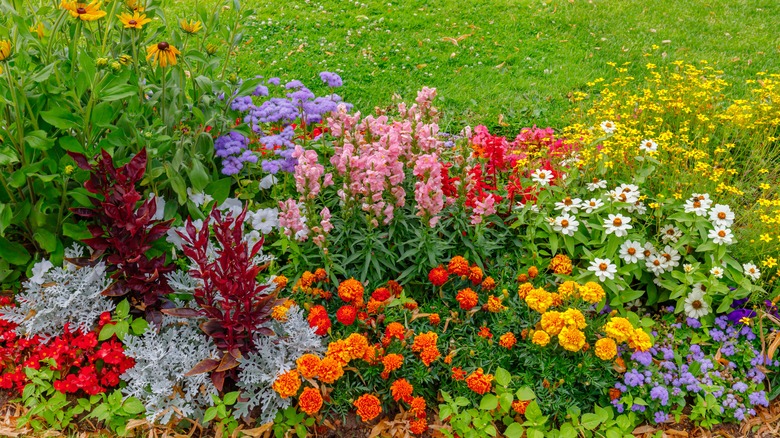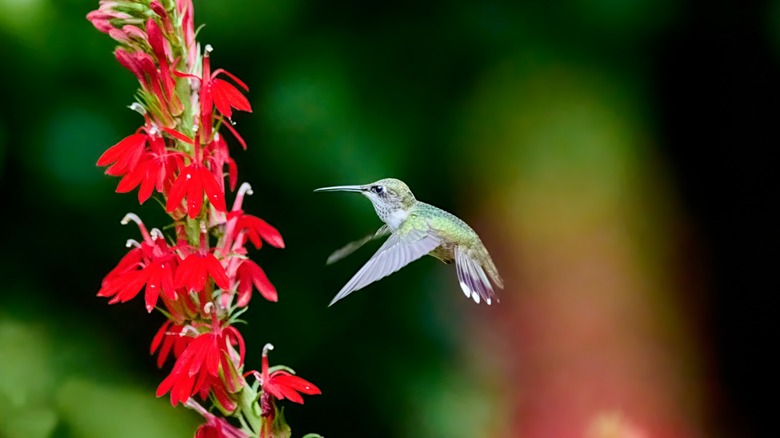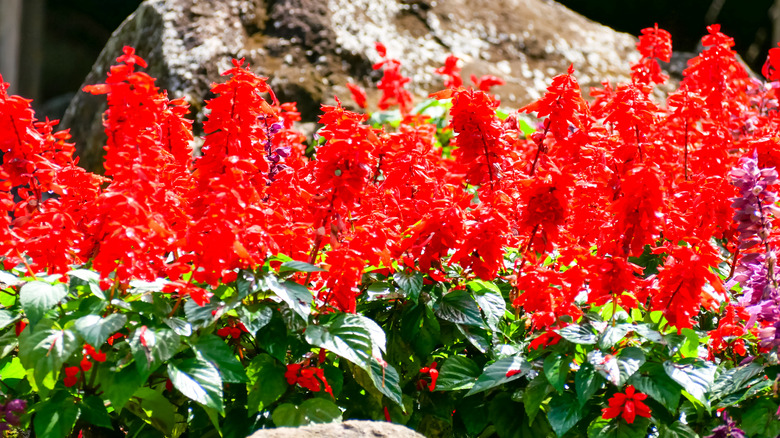The Colorful Flower You Should Add To Your Garden To Attract Hummingbirds
Rolling out a red carpet of cardinal flowers (Lobelia cardinalis) can transform your garden into a hummingbird hotspot. Monikered so as their vermilion inflorescence uncannily matches the reds of Roman Catholic cardinals' vestures, these flowers produce sweet nectar to entice hummers. They sweeten the deal further by attracting egg-laying pollinators, like butterflies, whose younglings songbirds devour to fulfill their nutritional quota.
These American natives add interest to your yard through the summer and the fall with their straight, 2- to 4-foot-long spikes (racemes) that support 1 1⁄2-inch-long tubular blooms. While mostly red, like the Queen Victoria cultivar, pink and white flower varieties are available too. The blooms precede top-opening, dual-chambered seed capsules that augment the plant's propagation through self-seeding. The two-lipped blooms splendidly juxtapose with the glossy green, 4-inch-long lance-shaped, serrated foliage that overwinters when the flowers have withered; you can enjoy evergreen leafy rosettes during the cold weather.
Cardinal-hummingbird mutualism
Certain plants are known to develop in tandem with hummingbirds, especially ruby-throated hummers (Archilochus colubris). Their tubelike flowers are the perfect size for hummers to fit their beaks and drink the nectar lying deep within. The velvety red hues lure them in, too. This is important as many pollinators, including most bees and insects, find traversing their flowers insurmountable, complicating pollination. As such, ruby hummers are the lone pollinators worth the name east of the plains. Since cardinals bloom from the ground up, different flowers exhibit male or female characteristics at any time. So, when the hummers hover at a flower to feed, their heads brush past the male anthers that deposit pollen on their heads. This pollen gets transferred to the stigma (female parts) of other flowers because the hummers dart between blossoms, promoting cross-pollination.
Conversely, hummingbirds benefit from easy access to nectar. After all, migrating over 500 miles in under a day consumes significant energy. As cardinals' blooming time coincides with their fall migration, the hummers are sorted for their journey. They also wipe out any aphids, spiders, gnats, and flies bothering your flowers without missing a wingbeat.
Cardinal planting conditions
Although growing lobelia plants is an assured way to craft a hummingbird paradise, it may not work for all gardeners. Cardinal flowers thrive only in moist soils in zones 3 to 9. So, they're best planted as edgings around ponds, streams, or downspouts, although they'll naturalize in rain gardens, too. They love water, easily tolerating seasonal flooding, making them a God-send to all brown thumbs who tend to overwater their plants. They tolerate full sun in wet soil but prefer being partly shaded in hotter climates. If you live in particularly windy areas, consider staking the flowering perennial. They also repel deer and rabbits.
Often touted as short-lived flowers, cardinals are anything but. The issue arises when overwintering plants are thickly covered with mulch and dead leaves to protect against cold damage. This practice impedes photosynthesis, starving the plant before spring sets in. When allowed to flower, the winterizing clump gives way to multiple offsets that can be divided and planted to get new cardinal flowers. Alternatively, when the plant produces seed pods, shake the stem and sow the released seeds into the wet substrate. Don't forget to keep your pets away from lobelia, as it contains poisonous alkaloids that are fatal when consumed in higher quantities. Remember, songbirds prefer a buffet over singular varieties, so interplant several flowers that hummingbirds love to keep them interested.


